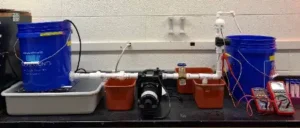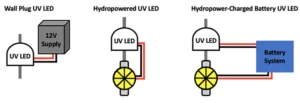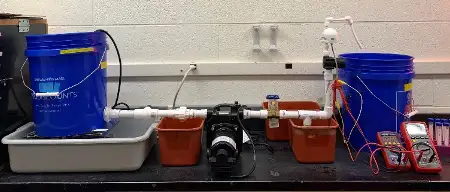By Liz Stevens, writer, UV Solutions
In water disinfection, as in so many other things, one size does not fit all. The differences in geographic location, site accessibility, available energy, local culture and economic condition among water users create unique demands for planning, installing and operating water disinfection technology. Technological options, UV type and wavelength combinations and energy alternatives can coalesce for a successful water disinfection project while a lack of viable choices can derail a project entirely, leaving a community without reliable access to the clean water necessary for health and well-being.
Researchers, however, love a challenge. The payoff from their long hours invested in research, testing and experimentation, plus the X factor – human ingenuity – can be extremely rewarding when an important challenge is met. Today’s challenges in supplying clean water to remote locations or impoverished communities exist at a time when options in UV technology are expanding and when alternative energy sources are multiplying.
 Daniel Ma, a Ph.D. candidate in Civil Engineering at The Ohio State University, and his adviser, Dr. Natalie Hull, previously an assistant professor and currently an adjunct assistant professor in Civil, Environmental and Geodetic Engineering at Ohio State and currently a clinical assistant professor at Boise State University in Civil Engineering, are digging into the additional disinfection options provided by UV LED technology and the energy-generating potential of hydropower. Their patent-pending advances offer important new possibilities for meeting the clean water needs of a thirsty planet.
Daniel Ma, a Ph.D. candidate in Civil Engineering at The Ohio State University, and his adviser, Dr. Natalie Hull, previously an assistant professor and currently an adjunct assistant professor in Civil, Environmental and Geodetic Engineering at Ohio State and currently a clinical assistant professor at Boise State University in Civil Engineering, are digging into the additional disinfection options provided by UV LED technology and the energy-generating potential of hydropower. Their patent-pending advances offer important new possibilities for meeting the clean water needs of a thirsty planet.
The researchers have built upon Hull’s previous Ph.D. work, which is typified in her journal article “Synergy of MS2 disinfection by sequential exposure to tailored UV wavelengths,” co-authored by Karl G. Linden. 1 In the article, Hull and Linden discuss the use of polychromatic UV light of various lamp types to create sequential UV exposures that yield an unexpected synergy in disinfecting against the MS2 bacteriophage, along with discussing the energy requirements of the various UV technologies. For their investigation, Ma and Hull have built out the polychromatic wavelength, multi-technology UV lamp variables and multi-sequence possibilities while also including variable energy sources: conventional 12 V utility electricity; hydropower, as produced by different turbine sizes; and battery storage for turbine-generated electricity.
Ma, with Hull as co-author, presented their findings in “Hydropowered and wavelength-optimized UV for distributed water disinfection” at the 2023 IUVA World Conference. This article hits the high points of the presentation that outlined the investigation and reveals the current status of Ma and Hull’s work on these topics.
For the research, Ma and Hull identified three objectives – to design and test hydropowered UV disinfection reactors, to evaluate alternatives for reducing the power requirements of the UV lamps and to assess the feasibility of installing hydropowered UV disinfection systems in the field. They tested a trio of UV lamp types offering five UV wavelengths against two different microorganisms, including using sequential UV exposures and different combinations of sequential exposures. The test setups included collimated beam experiments using single UV exposures and sequential exposures of five UV wavelengths and flow through experiments in which the single and sequential UV exposures were tested in concert with evaluating hydropower for running the UV reactors. Sequential UV exposures were evaluated for two reasons – to learn if disinfection is enhanced by their use and to research whether a mix of UV sources can cut the total amount of operating energy required. Power for the UV technology included 12 V wall plug electricity, hydropower turbine and a battery charged via hydropower. Turbines of the pico-hydro scale were used. Point of use for a household and point of entry scenarios for household, residential and commercial buildings were considered in the project.
The microorganisms used to test disinfection were MS2 and E. coli. The researchers used Ushio KrCl excimer lamps at 222 nm wavelength, conventional mercury low pressure lamps at 254 nm and AquiSense LED UV lamps at 255 nm, 265 nm and 285 nm wavelengths. The pico hydro turbine used was a 12-volt unit that outputs 10 watts and is widely available. For battery storage of energy, a 3 x 6600 mAh, 3.7 V in-series lithium-ion battery system was used.
Hydropowered disinfection reactor performance
Flow through testing results varied for hydropowered UV LED disinfection reactors depending upon the energy source and the water flow rate. 12 V wall plug energy was used to establish baseline disinfection performance for MS2, achieving a wide range of log 10 reduction at flow rates of 1 to 12 liters per minute. The inline hydropower turbine could only power the UV LEDs to achieve < 0.5 log 10 reduction for flow rates between 2 to 10 liters per minute. Lastly, 12 V battery power charged by the turbine, delivered log 10 reduction ranging from low to mid-range at relatively low flow rates, achieving similar disinfection as the 12 V wall plug for comparable flow rates.
Disinfection performance of UV exposures
Ma and Hull sought to test the performance and energy requirements for UV disinfection via single exposure and multi-wavelength sequential exposures. One benefit of multi-wavelength exposure is that it could deliver greater log reduction in a targeted microorganism or be used for disinfection of multiple microorganisms. Another possible benefit is a disinfection performance boost through synergy, which was identified in the investigation. “Synergistic disinfection,” said Ma, “was determined from observing that sequential exposures may have slightly higher disinfection than predicted by simply adding the inactivation observed by the two wavelengths.” In the sequential disinfection collimated beam experiments, the researchers exposed microbial samples to two wavelengths, with each wavelength contributing half of the total dose (e.g., 20 mJ/cm2 each by 254 nm and 285 nm, for a total of 40 mJ/cm2). “We used single wavelength dose response kinetics to predict the contribution of inactivation by each wavelength during the sequential disinfection,” he explained. “We saw in some wavelength combinations that the observed sequential dose responses were higher than the predicted added dose responses.” This synergy, however, was not seen in similar tests of flow through disinfection.
 In evaluating the electrical energy required for a 1-log reduction of MS2 by using UV LEDs and other UV sources for single or sequential exposures, Ma and Hull found that sequential exposures utilizing a mix of LED, low pressure and excimer lamps consumed significantly less energy than comparable single LED exposures. They are currently testing a theory of how the microbes respond to sequential wavelength exposure and how that might be used to inform future multi-wavelength disinfection for multi-target inactivation (e.g., proteins and DNA). “Another exploration,” said Ma, “is to test whether there is a disinfection and energy use benefit to using sequential wavelengths in UV system reactor design (e.g., in existing LP systems retrofitted with UV LEDs and what wavelength UV LED).”
In evaluating the electrical energy required for a 1-log reduction of MS2 by using UV LEDs and other UV sources for single or sequential exposures, Ma and Hull found that sequential exposures utilizing a mix of LED, low pressure and excimer lamps consumed significantly less energy than comparable single LED exposures. They are currently testing a theory of how the microbes respond to sequential wavelength exposure and how that might be used to inform future multi-wavelength disinfection for multi-target inactivation (e.g., proteins and DNA). “Another exploration,” said Ma, “is to test whether there is a disinfection and energy use benefit to using sequential wavelengths in UV system reactor design (e.g., in existing LP systems retrofitted with UV LEDs and what wavelength UV LED).”
Installing hydropowered UV reactors in the field
The research suggests that point-of-use hydropowered UV disinfection is a promising method in areas where water pressure is great enough for turbines to operate effectively. Their research, currently under a provisional patent, 2 indicates that hydropowered UV disinfection at the point-of-entry scale is feasible theoretically, but testing of this was not performed.
Ma explained that success in using hydropower to operate UV water disinfection can depend on the water system and the geography of a particular location. “A gravity-fed system through a mountainous region could operate without additional pressurization of the water to spin the turbine,” Ma said. “I have worked, for example, on designing systems in Vanuatu and Tanzania where there is great potential for electricity generation in remote areas to improve microbial water quality. The existing water pressure should be determined before concluding that a site is a good fit for implementation. Good areas for implementing gravity fed systems might include buildings or water distribution systems with high pressure zones or end of pipe areas that do not require high pressures.”
Where hydropowered turbine energy is not sufficient to operate UV disinfection reactors, battery storage of generated energy can be used. “In our proof-of-concept model,” said Ma, “we used a lithium-ion battery system (3 x 6600 mAh, 3.7 V in series) to be charged by the pico-hydro turbine in an in-pipe application.” A possible application of this battery-powered system would be for a site that only has intermittent potable water consumption along with regular non-potable water use. “In this scenario,” Ma explained, “during periods of non-potable water use, the battery could be charged by the water flowing past the turbine. When needed, the battery power supply then could be switched on for UV treatment of potable water.” One challenge that is presented by a pico-hydro UV system is the mismatch in optimal flow rate range for UV treatment and for power generation. To match the low output of the smallest turbines due to a low water flow rate, UV LED systems could be designed with this type of on/off, charging/draining battery application in mind to further reduce the power required for disinfection.
Ma’s presentation at the 2023 IUVA World Conference in Dubai gave him an opportunity to talk with UV industry leaders. “An important lesson that I learned from those conversations was about the design of UV LED reactors,” he said. “Different manufacturers of UV LED reactors for water disinfection have different philosophies of design, and that is reflected in their products’ performance, lifespan, durability and adaptability. Understanding the varied philosophies is an important consideration for the future of hydro-powered UV reactors in terms of performance, maintenance and useful lifespan.”
On the horizon
Ma and Hull have a patent pending and they are working on design and optimization of a pilot for larger-scale hydropower-UV systems. “One of the initial goals of the project,” said Ma, “was to develop an integrated design of the turbine and the UV LEDs. We are looking for potential industry supporters for electrical, instrumentation and control systems support for the integrated design. We are open to discussing opportunities to collaborate with industry partners to develop this into a technology for advancing the safe and appropriate use of UV to meet global water needs around the world, especially in areas that may be lacking access to electricity but that have ample water resources and potential hydropower to tap.”
The pair also look forward to working with the Ohio Environmental Protect Agency and local water utilities to consider ways in which hydro-powered UV water disinfection can be applied to rural and decentralized areas in the US. “I believe that hydropowered UV technology can be beneficial for rural and developing communities,” said Ma, “where there is a need for both electricity and water treatment. Hydropowered UV offers a unique and innovative self-powered solution for areas where there is an existing pressurized water supply, such as gravity-fed water tanks and distribution systems, elevated rainwater harvesting tanks or even run-of-river turbines treating a diverted water source for drinking water.”
The water needs for today, tomorrow and the next day exist in diverse locations with varied accessibility, economics, reliability of energy sources, cultures and geographies. A variety of approaches, technologies and configurations will be required to address those needs. To this end, options and alternatives will allow for customizing and finetuning treatment systems to match the setting. Ma and Hull’s work in studying UV lamp types, wavelength combinations and creative hydropower sources identifies valuable new choices for designing effective and efficient disinfection systems.
For more information on Ma and Hull’s research, visit protocols.io for polychromatic and photorepair fluence response protocols that are available for the UV community to use and are open for comments.
References
- Hull NM, Linden KG. Synergy of MS2 disinfection by sequential exposure to tailored UV wavelengths. Water Res. 2018 Oct 15;143:292-300. doi: 10.1016/j.watres.2018.06.017. Epub 2018 Jun 18. PMID: 29986239.
- Provisional patent filing. Title: STRATEGY AND OPTIMIZATION OF COMBINING HYDROPOWER AND UV WATER TREATMENT; Applicant: Ohio State Innovation Foundation; Inventor: Natalie Hull, et al.; Application No.: 63/595,824; Filing Date: November 3, 2023; MCC Reference: 103361-614PV1; Your Reference: T2024-133.





